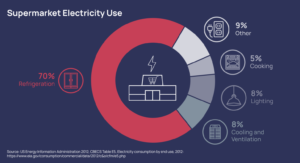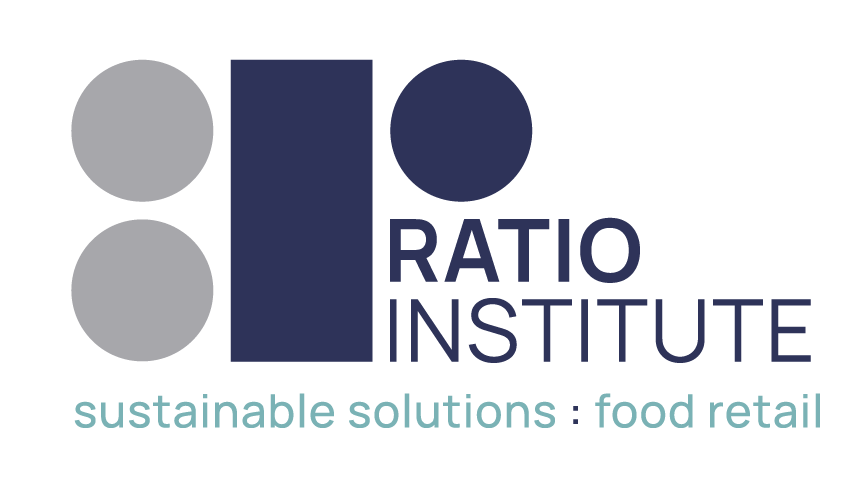Is Climate Change Food Retail’s Achilles Heel – or its Biggest Opportunity?
May 15, 2021|Heather Putnam
Food retailers are already dealing with the effects of climate change on their businesses. Increased dramatic weather events—more intense and more frequent hurricanes, wildfires, tornadoes, and extreme snow and rain—damage property and impact just-in-time supply chains that keep shelves stocked and communities fed. Some industry actors have been working to up their game in terms of risk assessment, disaster preparedness, and crisis management. H-E-B in Texas is arguably the weather vane for food retail climate change adaptation: the company’s emergency supply chain protocols, optimized delivery network, and fleet of mobile disaster trailers kept communities stocked with food and necessities during both Hurricane Harvey in 2017 and Winter Storm Uri in 2021.
Why Else Should Food Retailers Care About Climate Change?
Beyond climate change adaptation, the industry has not had a wholesale reckoning of its climate change impact, let alone an industry-wide conversation about strategic climate change mitigation. Much of the attention on mitigating GHGs in our food system has focused on food production and transportation, not on food retailers themselves. This has allowed the food retail industry to escape the negative press and attention that have driven other industries, such as high tech, to commit to actions aimed at reducing carbon emissions.
But the industry won’t escape notice for much longer. If retailers don’t act now to reduce emissions in their operations on their own terms, they will need to do it later under someone else’s terms and, in the process, may lose their social license to operate. Taking strategic action now means that retailers can plan for the investment and earn the position of climate leader instead of climate pariah.
Impact and Opportunity
Food retail is the nexus of our food system, where production, distribution, and consumption intersect. This means that reducing GHG emissions in facilities and the supply chain could have a meaningful impact on reducing global emissions. Reducing emissions is also in line with the values of increasingly savvy customers and future-proofs the industry against new climate change regulations coming down the pipeline. Finally, reducing GHG emissions can have positive health impacts on the communities that the businesses serve. This is especially critical for communities that do not meet ambient air quality standards.
The retail grocery sector has an outsize impact on climate change. According to the EPA, the average grocery store emits 1,383 metric tonnes of CO2 per year from energy consumption alone and another 1,556 metric tonnes of CO2 eq from leaked refrigerants. That means the average grocery store is annually emitting the equivalent CO2 emissions of 635 passenger cars. At 38,000 supermarkets in the United States, that means a carbon footprint of at least 112 million metric tonnes in Scope 1 emissions alone. This does not even include emissions generated by food waste going to landfills or plastic waste.
Reducing GHG emissions in operations makes sense for business. In fact, an argument can be made that such reductions are critical for the business to survive. Supermarkets have high energy use intensity compared to other commercial building types. The industry operates with a less than 2% margin, and the average grocery store spends about $200,000 per year on energy, or about $4 per square foot. So, reducing energy expenditures can have a significant impact on operational costs and increase the viability of the business. Additionally, lowering energy costs reduces a retailer’s exposure to energy market volatility and rising energy prices.
Food Retail Is the Biggest Retail Energy Consumer

While other industries have made major efforts to reduce their energy usage, few food retailers have invested in strategic energy efficiency in facilities, and even fewer have invested in renewable energy. Supermarket facilities are some of the most energy-intensive commercial buildings, consuming an average of 50 kilowatt-hoursper square foot per year. Over 90% of typical supermarket energy consumption is attributed to refrigeration and lighting systems, and these, followed by HVAC systems, offer the biggest bang for the buck in terms of energy savings. Energy-saving measures can be categorized into two groups: (1) no- or low-cost measures or behavior changes and (2) capital improvements.
Low-Cost Efficiency Opportunities
Ratio Institute staff have conducted over 500 educational audits in grocery stores and have found that in 15 minutes, auditors using a simple checklist can identify enough no- or low-cost energy efficiency opportunities to generate $15,000 of annual energy savings. Such opportunities can include
- regularly monitoring equipment to predict maintenance needs,
- removing lights in breakroom vending machines,
- turning off appliances overnight or when they’re not in use,
- ensuring that refrigerated return air vents are free of obstructions, and
- keeping walk-in freezer doors closed when they’re not in use.
Building Efficiency and Clean Energy Opportunities
Investments in equipment upgrades can immediately result in operational cost reductions. Such investments may include
- upgrading to LED lighting in overhead lights, display cases, and parking lots;
- investing in high-efficiency commercial food service equipment, like refrigerators and freezers;
- installing doors on open display cases;
- installing advanced refrigeration controls;
- installing adiabatic condensers in warm climates;
- adding alarms and auto-closers to walk-in cooler and freezer doors; and
- installing variable speed drives on fan motors.
Building efficiency is a strategy that is cost-effective and immediately implementable. Going one step further to convert stores to a renewable energy source like solar panels has even better economics. A 2015 study on big box and retail stores found that installing rooftop solar panels could offset energy costs by as much as 42%, a savings of about $84,000 annually for an average-size store. Some larger food retail chains, including Whole Foods and Kroger, have already invested in solar energy. As the price of solar continues to decrease, the option becomes more viable for smaller retailers as well, especially with available incentives like the federal 26% tax credit for solar projects.
Natural Refrigerants: A Big Global Warming Bang for Your Buck
In addition to energy consumption, refrigerants used in grocery stores are major global warming culprits. Traditional refrigerants like hydrofluorocarbons (HFCs) have been recognized for decades as having a global warming potential (GWP) value thousands of times higher than carbon dioxide. A major source of emissions is leakage of traditional refrigerants. Food retailers can mitigate leakage of HFCs by installing automated leak detection and tracking refrigerant use, leaks, and repairs (which is required by the EPA). The EPA’s GreenChill program offers resources and tools for food retailers to effectively manage refrigerants.
More significant reductions in emissions can be obtained by converting to natural refrigerants like ammonia and carbon dioxide, and with the ramp-up in compliance costs, converting can be a cost-saving measure as well. The cost of maintaining systems with HFC refrigerants is increasing due to required monitoring, reporting, and management of leaks. Switching to natural refrigerants reduces the risk and the overall lifetime cost of refrigeration equipment. For these reasons, the retail group ALDI Sud has converted to transcritical refrigeration systems in 1,496 stores across Europe, the United States, and Australia, providing a roadmap for the rest of the industry to follow suit.
There is an added economic benefit—and a positive environmental impact—of performing refrigeration energy efficiency upgrades and conversion to natural refrigerants in tandem; if a retailer invests in energy efficiency without investing in conversion to natural refrigerants at the same time, the energy investment becomes a stranded investment. Likewise, energy efficiency can provide cash flow through utility savings that will help offset the cost of refrigerant changes.
The Takeaway
The climate is rapidly changing. Pursuing strategic energy efficiency and renewable energy accomplishes three goals for the food retail industry: it reduces operating costs in the short-term; improves business viability in the face of shifting regulations, markets, and climates; and has a long-term impact on climate change. Ratio Institute staff have assisted food retailers in identifying strategies to reduce climate risk and improve profitability and will continue to work with retailers to recognize opportunities to stay ahead of the climate change curve.
This article was published in partnership with Presidio Graduate School.


